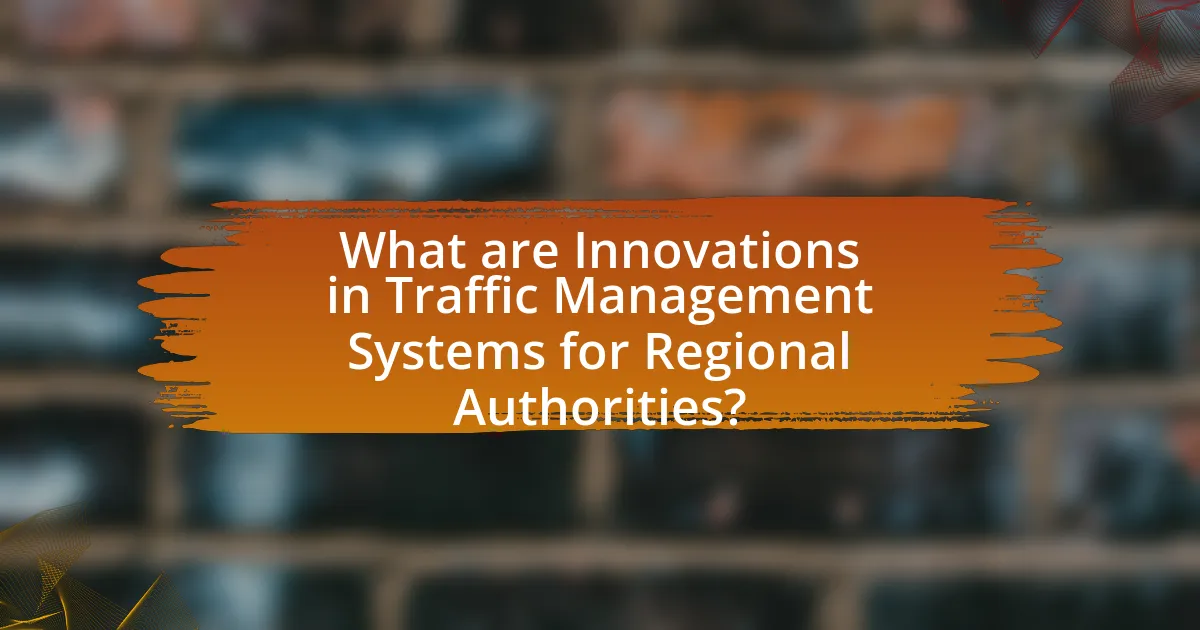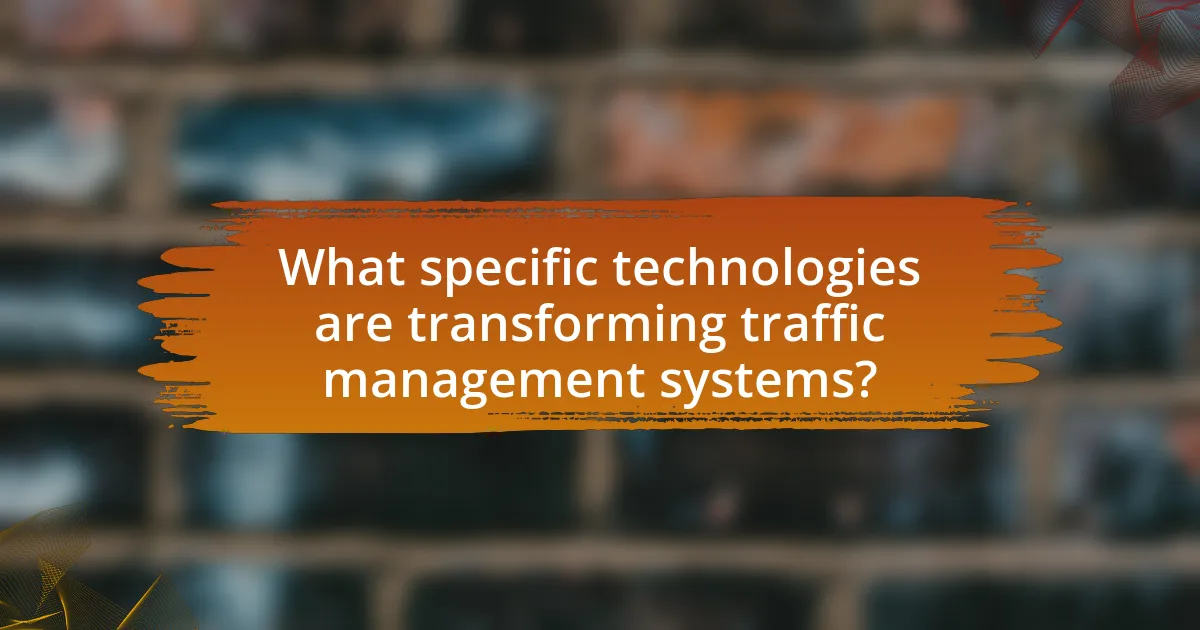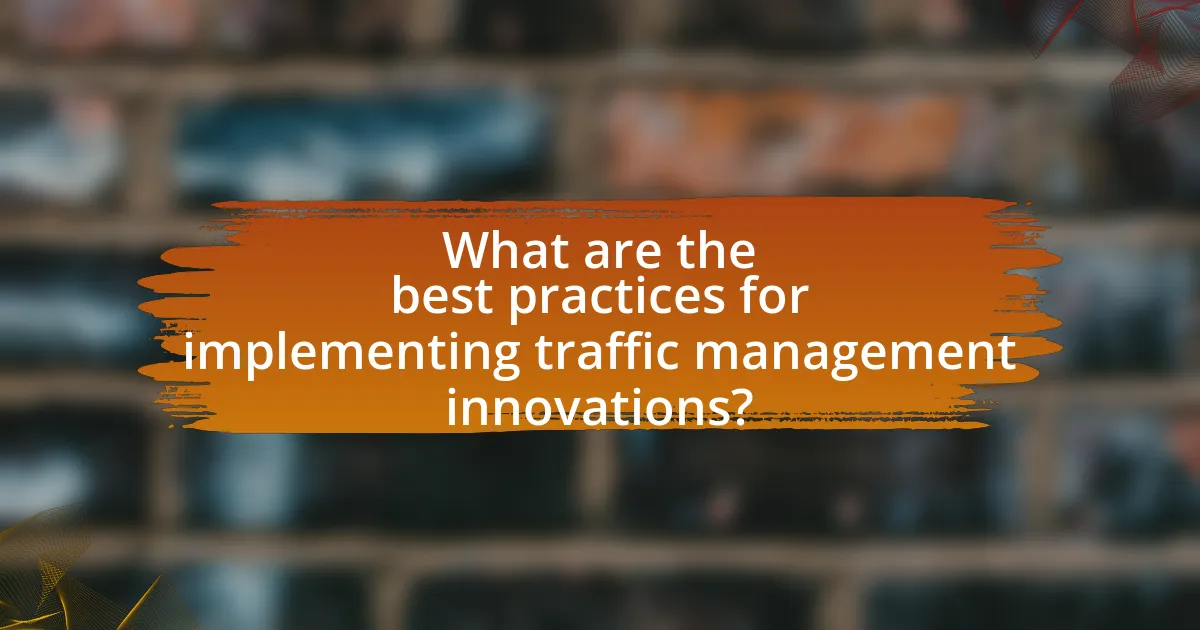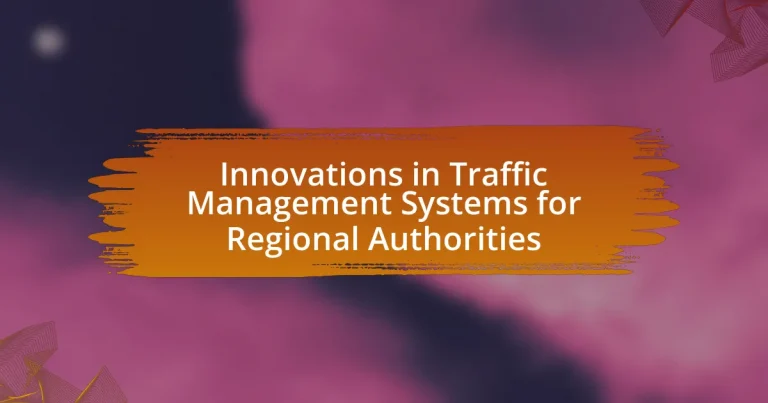Innovations in traffic management systems for regional authorities focus on advanced technologies such as smart traffic signals, real-time traffic monitoring, and integrated mobility platforms. These innovations aim to optimize traffic flow, enhance safety, and reduce congestion through the use of artificial intelligence, the Internet of Things, and big data analytics. The article discusses the impact of these technologies on regional traffic flow, the challenges faced by authorities, and the importance of data in improving traffic management. Additionally, it highlights best practices for implementation, potential drawbacks, and future trends in traffic management systems.

What are Innovations in Traffic Management Systems for Regional Authorities?
Innovations in traffic management systems for regional authorities include the implementation of smart traffic signals, real-time traffic monitoring, and integrated mobility platforms. Smart traffic signals utilize adaptive algorithms to optimize traffic flow based on real-time data, reducing congestion and improving travel times. Real-time traffic monitoring employs sensors and cameras to collect data on vehicle counts and speeds, enabling authorities to respond quickly to incidents and adjust traffic patterns accordingly. Integrated mobility platforms combine various transportation modes, such as public transit, ridesharing, and biking, into a single user-friendly interface, promoting efficient travel options. These innovations are supported by studies indicating that smart traffic systems can reduce travel times by up to 20% and decrease emissions by improving traffic flow.
How do these innovations impact regional traffic flow?
Innovations in traffic management systems significantly enhance regional traffic flow by optimizing traffic signal timings and improving real-time data analysis. These systems utilize advanced algorithms and machine learning to adjust traffic signals based on current traffic conditions, which reduces congestion and minimizes delays. For instance, cities that have implemented adaptive traffic signal control systems have reported reductions in travel times by up to 30% during peak hours. Additionally, the integration of real-time traffic monitoring and communication technologies allows for better incident management, leading to quicker responses to accidents and road obstructions, further improving overall traffic efficiency.
What technologies are driving these innovations?
Artificial Intelligence (AI), Internet of Things (IoT), and Big Data analytics are the primary technologies driving innovations in traffic management systems for regional authorities. AI enhances decision-making through predictive analytics and real-time traffic pattern recognition, while IoT devices, such as smart sensors and connected vehicles, facilitate data collection and communication between infrastructure and users. Big Data analytics processes vast amounts of traffic data to optimize traffic flow and reduce congestion. For instance, cities implementing AI-driven traffic signal control systems have reported up to a 30% reduction in travel time, demonstrating the effectiveness of these technologies in improving traffic management.
How do these innovations enhance safety on the roads?
Innovations in traffic management systems enhance safety on the roads by utilizing advanced technologies such as real-time data analytics, automated traffic signals, and vehicle-to-infrastructure communication. These systems improve traffic flow, reduce congestion, and minimize the likelihood of accidents. For instance, studies show that adaptive traffic signal control can decrease travel times by up to 20% and reduce collisions by 30% in urban areas. Additionally, the integration of smart sensors and cameras allows for immediate detection of hazardous conditions, enabling quicker responses from emergency services. This proactive approach to traffic management significantly contributes to safer road environments.
Why are regional authorities adopting new traffic management systems?
Regional authorities are adopting new traffic management systems to enhance efficiency and reduce congestion. These systems utilize advanced technologies such as real-time data analytics, artificial intelligence, and adaptive signal control to optimize traffic flow. For instance, cities implementing smart traffic lights have reported a reduction in travel times by up to 30%, demonstrating the effectiveness of these innovations in managing urban mobility challenges.
What challenges do regional authorities face in traffic management?
Regional authorities face several challenges in traffic management, including congestion, limited funding, and outdated infrastructure. Congestion is a significant issue, as urban areas experience increased vehicle volumes, leading to delays and reduced mobility. Limited funding restricts the ability of authorities to implement necessary upgrades or new technologies, which can enhance traffic flow and safety. Additionally, outdated infrastructure often lacks the capacity to accommodate modern traffic demands, making it difficult for regional authorities to effectively manage current and future transportation needs. These challenges hinder the implementation of innovative traffic management systems that could alleviate issues and improve overall efficiency.
How do innovations address these challenges?
Innovations in traffic management systems address challenges by utilizing advanced technologies such as real-time data analytics, artificial intelligence, and smart infrastructure. These technologies enhance traffic flow, reduce congestion, and improve safety by enabling dynamic traffic signal adjustments based on current conditions. For instance, studies have shown that cities implementing adaptive traffic signal control systems can reduce travel times by up to 20% and decrease accident rates by 30%. Additionally, innovations like connected vehicle technology facilitate communication between vehicles and infrastructure, further optimizing traffic management and enhancing overall efficiency.
What role does data play in traffic management innovations?
Data is crucial in traffic management innovations as it enables real-time monitoring and analysis of traffic patterns. By utilizing data from various sources such as sensors, GPS, and historical traffic records, traffic management systems can optimize signal timings, reduce congestion, and enhance overall road safety. For instance, cities employing data-driven traffic management have reported reductions in travel times by up to 30% and significant decreases in accident rates. This demonstrates that data not only informs decision-making but also leads to tangible improvements in traffic flow and safety outcomes.
How is data collected and analyzed in these systems?
Data in traffic management systems is collected through various methods, including sensors, cameras, and GPS data from vehicles. These systems utilize real-time data collection techniques to monitor traffic flow, vehicle speeds, and congestion levels. For example, inductive loop sensors embedded in roadways detect vehicle presence and count, while cameras provide visual data for traffic analysis. The collected data is then analyzed using algorithms and software tools to identify patterns, predict traffic conditions, and optimize traffic signal timings. This analytical approach enhances decision-making for regional authorities, leading to improved traffic management and reduced congestion.
What are the implications of real-time data for traffic management?
Real-time data significantly enhances traffic management by enabling immediate responses to changing traffic conditions. This capability allows traffic authorities to optimize signal timings, reduce congestion, and improve overall road safety. For instance, studies have shown that cities utilizing real-time data analytics can reduce travel times by up to 20% and decrease accident rates by 15%. Furthermore, real-time data facilitates better resource allocation, such as deploying emergency services more efficiently during incidents. The integration of real-time data into traffic management systems thus leads to more informed decision-making and improved urban mobility.
How do innovations in traffic management systems integrate with existing infrastructure?
Innovations in traffic management systems integrate with existing infrastructure through the use of advanced technologies such as adaptive traffic signals, real-time data analytics, and connected vehicle systems. These technologies enhance the efficiency of traditional traffic systems by allowing for dynamic adjustments based on current traffic conditions, thereby improving flow and reducing congestion. For instance, adaptive traffic signals can communicate with vehicles and adjust their timing based on real-time traffic patterns, which has been shown to reduce delays by up to 30% in urban areas. Additionally, the integration of sensors and cameras into existing infrastructure enables the collection of data that informs traffic management decisions, leading to more responsive and effective traffic control measures.
What are the potential drawbacks of implementing new traffic management technologies?
The potential drawbacks of implementing new traffic management technologies include high initial costs, complexity of integration, and potential data privacy concerns. High initial costs can deter regional authorities from adopting these technologies, as they may require significant investment in infrastructure and training. The complexity of integrating new systems with existing traffic management frameworks can lead to operational disruptions and inefficiencies during the transition period. Additionally, the collection and analysis of traffic data raise data privacy concerns, as sensitive information may be exposed or misused, leading to public distrust. These drawbacks highlight the challenges that regional authorities face when considering the adoption of innovative traffic management solutions.

What specific technologies are transforming traffic management systems?
Artificial Intelligence (AI), Internet of Things (IoT), and advanced data analytics are transforming traffic management systems. AI algorithms optimize traffic flow by predicting congestion patterns and adjusting signal timings in real-time. IoT devices, such as connected traffic cameras and sensors, gather data on vehicle counts and speeds, enabling more responsive traffic management. Advanced data analytics processes this information to provide insights for infrastructure improvements and policy decisions. For instance, cities implementing AI-driven traffic signal control have reported reductions in travel times by up to 25%, demonstrating the effectiveness of these technologies in enhancing urban mobility.
How do smart traffic signals work?
Smart traffic signals operate using sensors and algorithms to optimize traffic flow and reduce congestion. These signals collect real-time data on vehicle and pedestrian movements through various technologies, such as cameras, inductive loops, and radar. The data is processed by an integrated traffic management system that adjusts signal timings dynamically based on current traffic conditions, prioritizing the movement of vehicles and pedestrians efficiently. Studies have shown that smart traffic signals can reduce travel times by up to 30% and decrease emissions by minimizing idling, demonstrating their effectiveness in improving urban mobility.
What benefits do smart traffic signals provide to regional authorities?
Smart traffic signals provide regional authorities with enhanced traffic flow management, reduced congestion, and improved safety. These signals utilize real-time data and adaptive algorithms to optimize signal timing based on current traffic conditions, which can lead to a 20-30% reduction in travel time for vehicles. Additionally, studies have shown that smart traffic signals can decrease accident rates by up to 25% by improving vehicle and pedestrian interactions. This technology also supports environmental goals by reducing vehicle emissions through decreased idle times at intersections.
How do smart traffic signals adapt to changing traffic conditions?
Smart traffic signals adapt to changing traffic conditions by utilizing real-time data from various sources, including sensors, cameras, and vehicle detection systems. These signals analyze traffic flow, congestion levels, and pedestrian activity to adjust signal timings dynamically. For instance, studies have shown that adaptive traffic signal control systems can reduce delays by up to 30% and improve traffic throughput by 20% during peak hours. This adaptability is achieved through algorithms that process incoming data and optimize signal phases accordingly, ensuring efficient traffic management and enhanced safety for all road users.
What is the role of artificial intelligence in traffic management?
Artificial intelligence plays a crucial role in traffic management by optimizing traffic flow, reducing congestion, and enhancing safety. AI systems analyze real-time data from various sources, such as traffic cameras, sensors, and GPS devices, to predict traffic patterns and adjust signal timings accordingly. For instance, studies have shown that AI-driven traffic signal control can reduce delays by up to 30% and improve overall traffic efficiency. Additionally, AI algorithms can identify accident-prone areas and suggest preventive measures, contributing to safer road conditions.
How does AI improve traffic prediction and management?
AI improves traffic prediction and management by utilizing advanced algorithms and real-time data analysis to enhance accuracy and efficiency. These systems analyze vast amounts of data from various sources, such as traffic cameras, GPS devices, and social media, to predict traffic patterns and congestion. For instance, a study by the University of California, Berkeley, demonstrated that AI models could reduce traffic prediction errors by up to 30% compared to traditional methods. Additionally, AI-driven traffic management systems can dynamically adjust traffic signals and reroute vehicles, leading to reduced travel times and improved road safety.
What are the ethical considerations of using AI in traffic systems?
The ethical considerations of using AI in traffic systems include issues of privacy, accountability, and bias. Privacy concerns arise from the collection and analysis of vast amounts of data from vehicles and individuals, potentially infringing on personal freedoms. Accountability is critical, as it must be clear who is responsible for decisions made by AI systems, especially in cases of accidents or malfunctions. Additionally, bias in AI algorithms can lead to unfair treatment of certain groups, exacerbating existing inequalities in traffic enforcement and management. For instance, studies have shown that AI systems can reflect societal biases present in their training data, leading to disproportionate impacts on marginalized communities.
How are mobile applications influencing traffic management?
Mobile applications are significantly influencing traffic management by providing real-time data and communication tools that enhance traffic flow and safety. These applications enable users to receive live updates on traffic conditions, road closures, and alternative routes, which helps in reducing congestion. For instance, platforms like Waze utilize crowd-sourced data to inform users about traffic incidents, allowing for quicker route adjustments. According to a study by the Texas A&M Transportation Institute, the use of navigation apps can decrease travel time by up to 20% during peak hours. Additionally, mobile applications facilitate better coordination between traffic management centers and the public, leading to more efficient responses to traffic incidents and improved overall traffic management strategies.
What features do these applications offer to users?
Traffic management applications offer users features such as real-time traffic monitoring, route optimization, incident reporting, and data analytics. Real-time traffic monitoring allows users to receive updates on traffic conditions, enabling them to make informed travel decisions. Route optimization features suggest the fastest or least congested paths based on current traffic data. Incident reporting allows users to report accidents or road hazards, contributing to community safety and awareness. Data analytics provides insights into traffic patterns, helping regional authorities improve infrastructure and planning. These features collectively enhance user experience and contribute to more efficient traffic management.
How do these applications facilitate communication between authorities and the public?
Applications in traffic management systems facilitate communication between authorities and the public by providing real-time information and feedback mechanisms. These applications enable authorities to disseminate updates on traffic conditions, road closures, and safety alerts directly to the public through mobile notifications and web platforms. For instance, systems like Waze and local government apps allow users to report incidents, which authorities can then address promptly, enhancing public safety and responsiveness. Additionally, data analytics from these applications help authorities understand public concerns and improve traffic management strategies, thereby fostering a two-way communication channel that is essential for effective governance.

What are the best practices for implementing traffic management innovations?
The best practices for implementing traffic management innovations include conducting thorough data analysis, engaging stakeholders, and utilizing adaptive technologies. Data analysis allows authorities to identify traffic patterns and problem areas, which is essential for informed decision-making. Engaging stakeholders, such as local communities and businesses, ensures that the innovations meet the needs of those affected by traffic changes. Utilizing adaptive technologies, such as real-time traffic monitoring systems and smart traffic signals, enhances responsiveness to changing traffic conditions. These practices are supported by studies showing that data-driven approaches can reduce congestion by up to 30%, while stakeholder engagement increases public acceptance and compliance with new traffic measures.
How can regional authorities ensure successful adoption of new technologies?
Regional authorities can ensure successful adoption of new technologies by implementing comprehensive training programs for staff and stakeholders. These programs should focus on the specific functionalities and benefits of the new technologies, ensuring that users are well-equipped to utilize them effectively. For instance, a study by the International Transport Forum highlighted that regions with robust training initiatives saw a 30% increase in technology utilization rates compared to those without such programs. Additionally, fostering collaboration between technology providers and local agencies can facilitate smoother integration and address any operational challenges that arise during the adoption process.
What training is necessary for staff to manage new systems effectively?
Staff must undergo comprehensive training that includes system-specific technical training, user interface navigation, data analysis, and troubleshooting skills to manage new traffic management systems effectively. This training ensures that staff are proficient in utilizing the features of the new systems, understanding data inputs and outputs, and resolving common issues that may arise during operation. Research indicates that organizations that invest in targeted training programs see a 30% increase in operational efficiency, demonstrating the importance of equipping staff with the necessary skills to adapt to technological innovations in traffic management.
How can public awareness campaigns support the implementation process?
Public awareness campaigns can significantly support the implementation process of innovations in traffic management systems by educating the community about new technologies and practices. These campaigns raise awareness of the benefits, such as improved safety and reduced congestion, which can lead to greater public acceptance and participation. For instance, studies have shown that communities with effective public awareness initiatives experience higher compliance rates with new traffic regulations and technologies, as seen in the implementation of smart traffic signals in various cities. By fostering a well-informed public, these campaigns can enhance the overall effectiveness and sustainability of traffic management innovations.
What are common pitfalls to avoid when upgrading traffic management systems?
Common pitfalls to avoid when upgrading traffic management systems include inadequate stakeholder engagement, insufficient data analysis, and neglecting system integration. Inadequate stakeholder engagement can lead to a lack of support and misalignment with community needs, as seen in projects where public input was minimal, resulting in low adoption rates. Insufficient data analysis may cause decision-makers to overlook critical traffic patterns, leading to ineffective solutions; for instance, a study by the Transportation Research Board highlighted that data-driven decisions significantly improve traffic flow outcomes. Lastly, neglecting system integration can result in fragmented operations, as evidenced by cases where new systems failed to communicate with existing infrastructure, causing operational inefficiencies.
How can regional authorities assess the effectiveness of new systems post-implementation?
Regional authorities can assess the effectiveness of new traffic management systems post-implementation by utilizing key performance indicators (KPIs) such as traffic flow efficiency, accident rates, and user satisfaction surveys. These metrics provide quantifiable data that can be analyzed to determine improvements in traffic conditions and overall system performance. For instance, a study by the Institute of Transportation Engineers found that cities implementing advanced traffic signal systems experienced a 20% reduction in travel time and a 30% decrease in accidents, demonstrating the tangible benefits of such innovations. Additionally, collecting feedback from users through surveys can help gauge public perception and identify areas for further enhancement.
What metrics should be used to evaluate traffic management innovations?
To evaluate traffic management innovations, key metrics include traffic flow efficiency, travel time reliability, accident rates, and user satisfaction. Traffic flow efficiency can be measured by the average speed of vehicles and the volume-to-capacity ratio on roadways, which indicates how well the infrastructure accommodates traffic. Travel time reliability assesses the consistency of travel times across different times of the day, often quantified through metrics like the Planning Time Index. Accident rates provide insight into safety improvements resulting from innovations, while user satisfaction can be gauged through surveys and feedback mechanisms. These metrics collectively offer a comprehensive view of the effectiveness and impact of traffic management innovations.
What future trends can we expect in traffic management systems?
Future trends in traffic management systems include the integration of artificial intelligence, real-time data analytics, and smart infrastructure. These advancements will enable more efficient traffic flow, reduce congestion, and enhance safety. For instance, AI algorithms can analyze traffic patterns and predict congestion, allowing for dynamic traffic signal adjustments. Additionally, the implementation of connected vehicle technology will facilitate communication between vehicles and traffic management systems, improving overall traffic coordination. According to a report by the International Transport Forum, cities adopting smart traffic management solutions have seen a reduction in travel times by up to 30%.
How might autonomous vehicles influence traffic management strategies?
Autonomous vehicles are likely to significantly enhance traffic management strategies by enabling real-time data sharing and coordinated traffic flow. These vehicles can communicate with traffic signals, other vehicles, and infrastructure, allowing for optimized routing and reduced congestion. For instance, studies indicate that the integration of autonomous vehicles can lead to a 20-30% reduction in traffic delays due to improved traffic signal timing and vehicle-to-infrastructure communication. This data-driven approach allows traffic management systems to adapt dynamically to changing conditions, improving overall road safety and efficiency.
What role will sustainability play in future traffic management innovations?
Sustainability will be a central component in future traffic management innovations by prioritizing eco-friendly practices and technologies that reduce emissions and enhance resource efficiency. Innovations such as smart traffic signals, which optimize traffic flow and minimize idling, can significantly decrease greenhouse gas emissions. Additionally, the integration of electric and autonomous vehicles into traffic systems will further support sustainability goals by reducing reliance on fossil fuels. Research indicates that cities implementing sustainable traffic management strategies can achieve up to a 30% reduction in carbon emissions, demonstrating the effectiveness of these innovations in promoting environmental responsibility.


